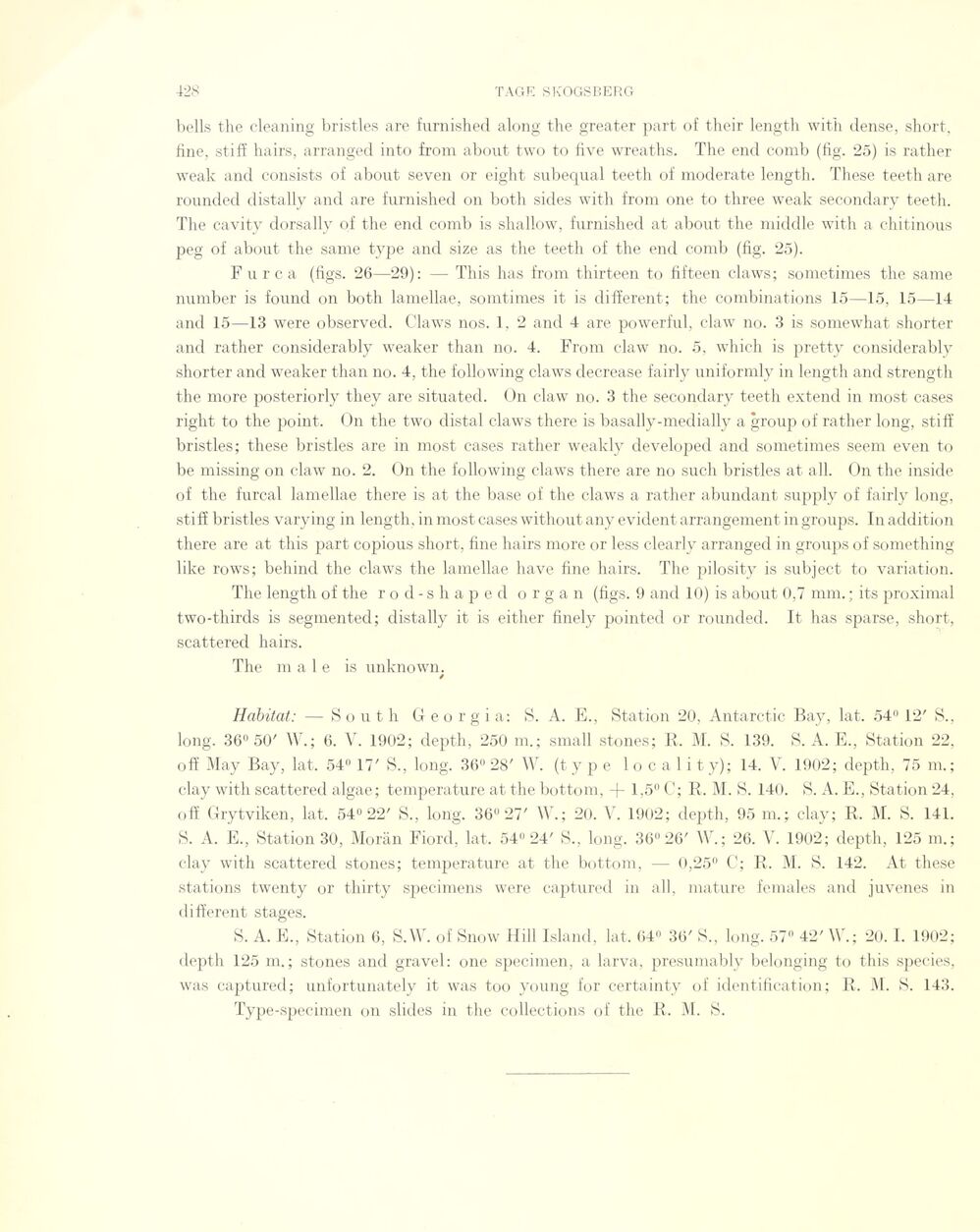
Full resolution (JPEG) - On this page / på denna sida - Sidor ...

<< prev. page << föreg. sida << >> nästa sida >> next page >>
Below is the raw OCR text
from the above scanned image.
Do you see an error? Proofread the page now!
Här nedan syns maskintolkade texten från faksimilbilden ovan.
Ser du något fel? Korrekturläs sidan nu!
This page has never been proofread. / Denna sida har aldrig korrekturlästs.
bells the cleaning bristles are furnished along the greater part of their length with dense, short,
fine, stiff hairs, arranged into from about two to five wreaths. The end comb (fig. 25) is rather
weak and consists of about seven or eight subequal teeth of moderate length. These teeth are
rounded distally and are furnished on both sides with from one to three weak secondary teeth.
The cavity dorsally of the end comb is shallow, furnished at about the middle with a chitinous
peg of about the same type and size as the teeth of the end comb (fig. 25).
Fu rca (figs. 26—29): — This has from thirteen to fifteen claws; sometimes the same
number is found on both lamellae, somtimes it is different; the combinations 15—15, 15—14
and 15—13 were observed. Claws nos. 1, 2 and 4 are powerful, claw no. 3 is somewhat shorter
and rather considerably weaker than no. 4. From claw no. 5, which is pretty considerably
shorter and weaker than no. 4, the folio wing claws decrease fairly uniformly in length and strength
the more posteriorly they are situated. On claw no. 3 the secondary teeth extend in most cases
right to the point. On the two distal claws there is basally-medially a group of rather long, stiff
bristles; these bristles are in most cases rather weakly developed and sometimes seem even to
be missing on claw no. 2. On the following claws there are no such bristles at all. On the inside
of the furcal lamellae there is at the base of the claws a rather abundant supply of fairly long,
stiff bristles varying in length, in most cases without any evident arrangement in groups. In addition
there are at this part copious short, fine hairs more or less clearly arranged in groups of something
like rows; behind the claws the lamellae have fine hairs. The pilosity is subject to variation.
The length of the rod-shaped organ (figs. 9 and 10) is about 0,7 mm. ; its proximal
two-thirds is segmented; distally it is either finely pointed or rounded. It has sparse, short,
scattered hairs.
The male is unknown.
Habitat: — South Georgia: S. A. E., Station 20, Antarctic Bay, lat. 54° 12’ S.,
long. 36° 50’ W.; 6. Y. 1902; depth, 250 m.; small stones; R. M. S. 139. S. A. E., Station 22,
ofî May Bay, lat. 54n 17’ S., long. 36° 28’ W. (t y p e 1 o c a 1 i t y); 14. V. 1902; depth, 75 m. ;
elay with scattered algae; temperature at the bottom, + 1,5° C; R. M. S. 140. S. A. E., Station 24,
ofî Grytviken, lat. 54° 22’ S., long. 36° 27’ W.; 20. V. 1902; depth, 95 m. ; clay; R. M. S. 141.
S. A. E., Station 30, Morän Fiord, lat. 54° 24’ S., long. 36° 26’ W.; 26. V. 1902; depth, 125 m.;
clay with scattered stones; temperature at the bottom, — 0,25° C; R. M. S. 142. At these
stations twenty or thirty specimens were captured iii ail, mature females and juvenes in
different stages.
S. A. E., Station 6, S.\V. of Snow Hill Island, lat. 64° 36’ S., long. 57n 42’ W.; 20. 1. 1902;
depth 125 m.; stones and gravel: one specimen, a larva, presumably belonging to this species,
was captured; unfortunately it was too young for certainty of identification; R. M. S. 143.
Type-specimen on slides in the collections of the R. M. S.
<< prev. page << föreg. sida << >> nästa sida >> next page >>